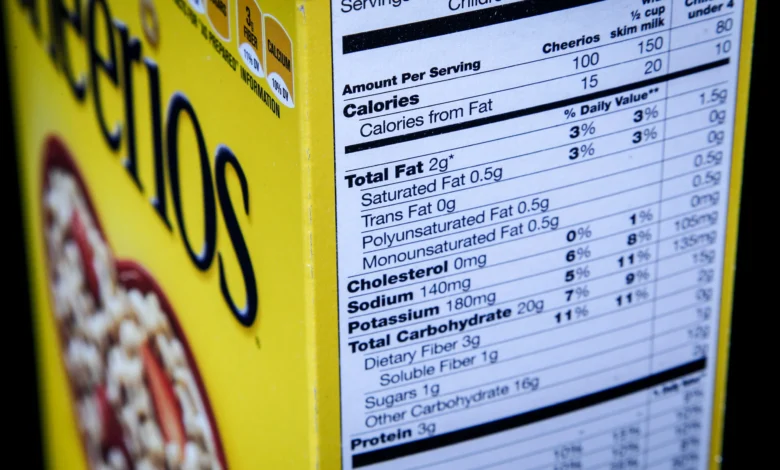Nutrition
“Navigating Nutrition Labels: A Comprehensive Guide to Essential Nutrition Facts

Embarking on a journey towards healthier eating involves understanding and decoding the essential information provided on nutrition labels. In this comprehensive guide, we will delve into various aspects of nutrition facts, empowering you to make informed decisions about the foods you consume. Presented in a bullet-point format, here’s an in-depth exploration of different nutrition facts:
- Serving Size Awareness:
Serving Size Significance: Understand the recommended serving size for accurate assessment of nutritional content.
Portion Control: Practice mindful eating to align with suggested serving sizes. - Total Calories per Serving:
Caloric Content Consideration: Take note of the total calories per serving to manage daily energy intake effectively.
Caloric Needs Evaluation: Assess how the caloric content fits into your daily energy requirements. - Macronutrient Breakdown:
Carbohydrates Insight: Identify the amount of carbohydrates, including dietary fiber and sugars.
Protein Assessment: Evaluate protein content for muscle support and satiety.
Fats Differentiation: Understand the types of fats present, with an emphasis on healthier unsaturated fats. - Micronutrient Content Exploration:
Vitamins and Minerals Recognition: Explore the presence of essential vitamins and minerals.
% Daily Value Understanding: Utilize % Daily Value to gauge a food item’s contribution to overall nutrient intake. - Fiber Focus for Digestive Health:
Dietary Fiber Significance: Recognize the role of fiber in promoting digestive health and satiety.
Choosing Fiber-Rich Foods: Prioritize foods high in fiber, such as whole grains, fruits, and vegetables. - Quality of Protein:
Complete vs. Incomplete Proteins: Differentiate between protein sources and aim for a well-rounded intake.
Plant-Based Protein Options: Explore plant-based protein sources for variety. - Understanding Fats:
Types of Fats Awareness: Differentiate between saturated, unsaturated, and trans fats for heart health.
Healthy Fat Choices: Opt for foods rich in healthy fats, such as avocados and nuts. - Awareness of Sugars and Sweeteners:
Natural vs. Added Sugars: Differentiate between sugars naturally occurring in foods and those added during processing.
Artificial Sweeteners Consideration: Be mindful of the impact of artificial sweeteners on your overall diet. - Sodium Savvy Choices:
Limiting Sodium Intake: Be aware of high sodium content, especially in processed and packaged foods.
Opting for Low-Sodium Alternatives: Choose products with lower sodium levels. - Identification of Common Allergens:
Allergens Recognition: Familiarize yourself with common allergens listed on food labels.
Preventing Cross-Contamination: Be cautious of potential allergen cross-contamination. - Unraveling Food Additives:
Preservatives and Additives Awareness: Understand common additives and their purposes in processed foods.
Colorings and Flavorings Consideration: Be mindful of artificial colorings and flavorings. - Smart Shopping Strategies:
Effective Label Reading: Take the time to read labels while grocery shopping for informed choices.
Product Comparison Skills: Compare similar products to select those with superior nutritional profiles. - Tailoring Nutrition for Individual Needs:
Personalized Nutritional Goals: Customize your diet based on individual health and fitness objectives.
Accommodating Dietary Preferences: Adjust your dietary choices to accommodate specific preferences or restrictions. - Meal Planning for Optimal Nutrition:
Balanced Meal Construction: Create meals that include a variety of nutrients for overall balance.
Preventing Nutrient Gaps: Plan meals to avoid deficiencies in essential nutrients. - Cooking Techniques for Nutrient Retention:
Healthy Cooking Methods: Opt for cooking methods that retain nutrients, such as steaming or sautéing.
Preserving Vitamin C: Minimize nutrient loss, especially vitamin C, during cooking. - Awareness of Misleading Marketing Tactics:
“Low-Fat” Traps: Be cautious of products labeled “low-fat,” which may compensate with added sugars.
“Organic” vs. Nutritional Value: Understand that “organic” doesn’t guarantee higher nutritional value. - The Role of Supplements:
Evaluating Supplement Needs: Consider supplements based on individual dietary gaps.
Seeking Professional Guidance: Consult healthcare professionals for advice on supplement use. - Integrating Nutrition into Lifestyle:
Balancing Treats: Enjoy occasional treats while maintaining an overall balanced diet.
Cultivating Sustainable Habits: Adopt nutritional habits that are sustainable for long-term health. - Staying Informed Strategies:
Continuous Learning Approach: Stay updated on nutritional trends and research.
Recipe Modification Skills: Learn to modify recipes for improved nutritional content. - Building a Supportive Community:
Knowledge Sharing: Share nutritional insights with friends and family.
Engaging with Communities: Connect with communities or online groups focused on informed eating.
Understanding nutrition facts is essential for making informed choices about the foods you consume. By decoding labels, embracing nutrient-rich foods, and cultivating informed habits, you pave the way for a healthier and more nourished lifestyle. Remember, informed eating is a journey, and each mindful choice contributes to your overall well-being



